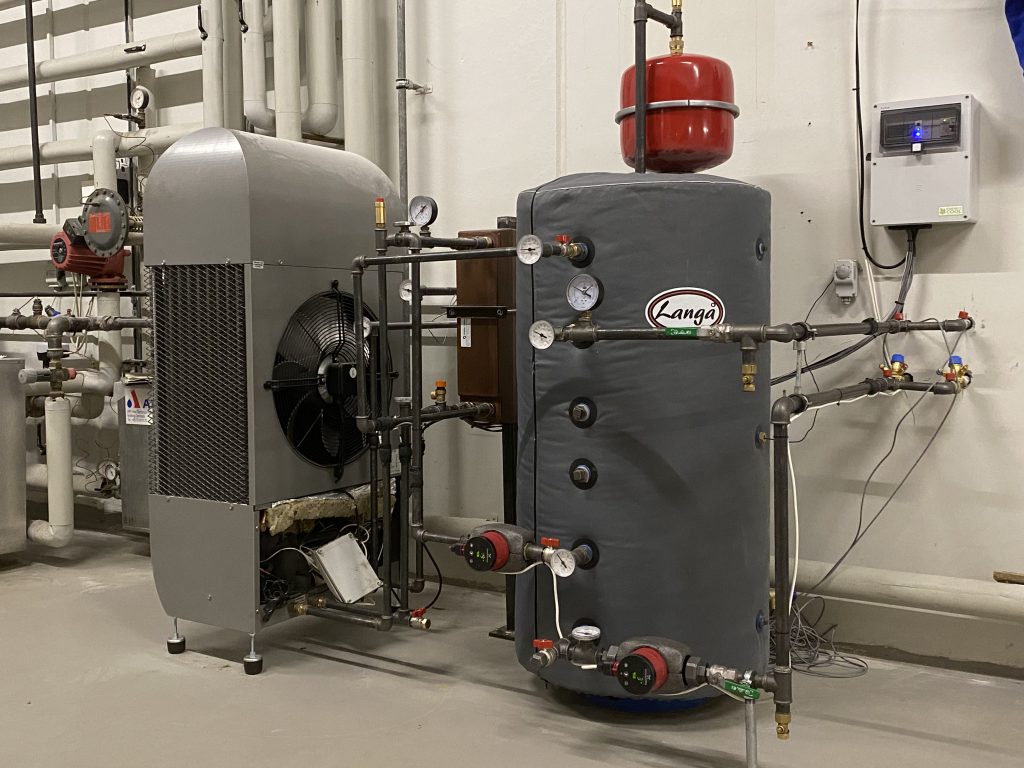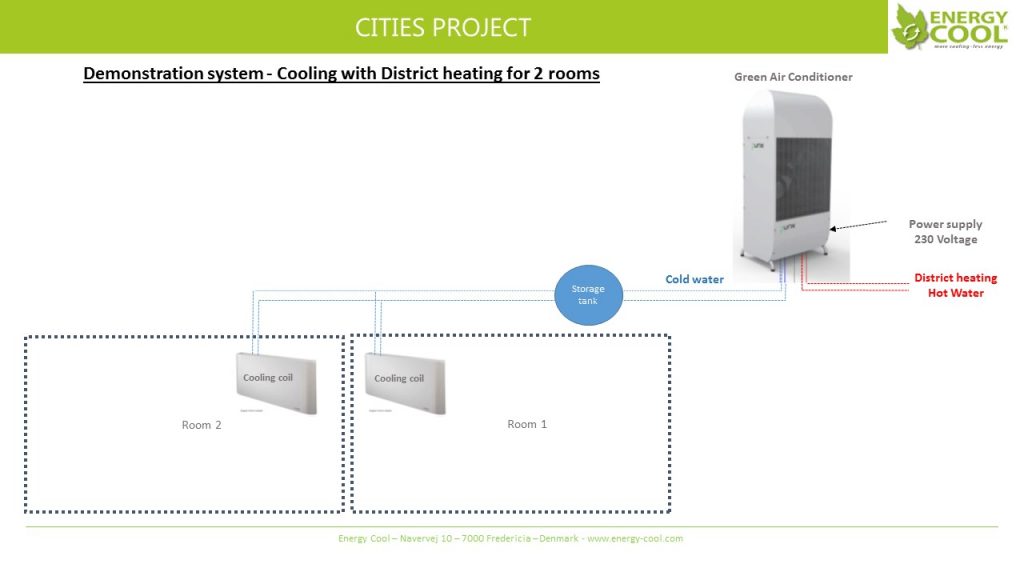New CITIES demonstration project explores how much energy it saves by connecting an absorption chiller to district heating as a green alternative to traditional air conditioning, e.g. in server rooms.
—
There are not much ‘sales’ in district heating in the summer at the several hundred district heating companies in Denmark. A test with flexible and intelligent cooling at Grindsted electricity and heating (GEV) in the coming summer might help to change that a bit.
GEV has installed an absorption chiller, which has to cool two meeting rooms. The pilot chiller is a small unit of 2.5 kW. It cools the district heating water from 60 degrees to 13-18 degrees and passes it through a valve into a fan coil to cool the air.
The district heating industry should not really make money beyond for the cooperatives; the project for GEV is more about a green profile and about saving operating costs. Therefore, the partners in the project expect the project moves the power consumption, saves energy for cooling and thus speaks into the green transition because it does not use environmentally harmful coolant.
– These kinds of units could be very interesting especially for heating companies for selling cooling in the summertime when the demand for heating is low. If this project will be successful, the heating companies could find additional demands on heating and get a business case out of it. However, the solution is especially suitable for factories, big stores with refrigeration needs and server rooms, Dominik Franjo Dominkovic, Postdoc at DTU Compute and demo project leader at CITIES, says.

Green energy or operational optimization
The Danish company Energy Cool, which usually sells small installations, where electricity is used exclusively for cooling, develops the set-up. Here, a model has been further developed to convert district heating to cooling water, which is used for comfort cooling of the two meeting rooms, explains Henrik Thorsen, Director, Energy Cool:
– Our normal source of supply is electricity, but this project is extremely exciting, as we can combine green district heating here, which in the summer period is surplus of precisely during the period when most cooling is needed.
– This CITIES project opens up completely new opportunities, to increase our storage technology and utilize green energy, as well as increase flexibility, which can thus contribute to the green transition. We hope with the project to be able to help reduce energy consumption, ensure that green energy is used and utilize surplus heat for cooling, he says.
Energy Cool works with storage technologies to minimize power consumption and shift it across the clock when the power is produced green or to optimize operation.
DTU has installed sensors at GEV to collect data about temperatures from the meeting rooms and the district heating water in the building, as well as power consumption. Energy Cool will deliver the data from sensors via the firm’s own cloud solution during the period from late spring to late summer.
– We will get data in real-time and based on that we will be able to test a simple model for demand response in relation to the energy and district heating prices on the energy market. According to that also to shut down the cooling production and increase it on other times based on the price, Dominik Franjo Dominkovic says.
The need for ventilation created the idea
The idea originally came about because GEV should have installed ventilation in the company’s office building. It would cost DKK 2 million to install a ventilation system. In addition, the electricity bill would also be expensive.
– That’s why we started looking at cheaper options with completely different and more ‘green’ glasses. By thinking carefully about and collaborating with the right people, we have found that using cooled district heating water to cool down warm rooms with, says Leif Jørgensen, operations and project manager at GEV.
Here the power consumption will be low and GEV can use some water that the company already has. Initially, the project runs on a small scale. The absorption chiller is installed in GEV’s heating plant and cools the water and passes it on to the ventilation units in the two meeting rooms, which were connected to the mains on April 1.
– The whole scam about this is also that in the long term we expect to be able to cool our office building with quite a few cooling units, which cost almost nothing. We also expect that even in the future we will be able to produce the small amount of power that the system requires using solar cells. But that will be the next step. Now we need it to run in the two meeting rooms, so the server room and then likely the whole office building, says Leif Jørgensen.
He also mentions the purely aesthetic. Radiators quickly look a little ugly. Here the cooling unit in each room is the size of a radiator but smooth on the outside. Finally, there is also energy in cooling down. Even though it is cold air, it can be used for district heating, for example with a heat pump. However, it will require some investment.
– You could easily replace a number of radiators in our office house, and then have them produce heat in the winter and cold in the summer, so that the same heat pipes supply hot water during the heating season and cold water in the summer season. Such a solution will be interesting. There is clearly a perspective in trying something. That’s what we can get out of this collaboration with DTU and Energy Cool in CITIES, says Leif Jørgensen.
The market for cooling is growing rapidly
Henrik Thorsen points out that the market for cooling is growing rapidly due to global warming, as well as increased data consumption, which requires the expansion of technical installations.
– There are huge prospects in converting heat to cooling, and we are proud to develop customized solutions in collaboration with DTU and CITIES that benefits our customers and especially the environment, Henrik Thorsen says.
At DTU Compute Professor and Project Manager at CITIES Henrik Madsen also links the demonstration project to other projects:
– Like other CITIES solutions, the idea is that the final solution will be scaled up for use in several other contexts at Denmark’s new digital hub for smart energy systems, Center Denmark.
With the location at Kolding, Center Denmark is located near key national players in the energy market, such as Energinet, Ørsted, EWII, TREFOR and Danish District Heating.
This location will help ensure that Center Denmark becomes the hub of the new Energy Silicon Valley in Trekantområdet between Vejle, Fredericia and Kolding. Center Denmark has a close association with all four technical universities in Denmark, as well as a number of key players for a smart green transition.
Learn more about the demo project here.

